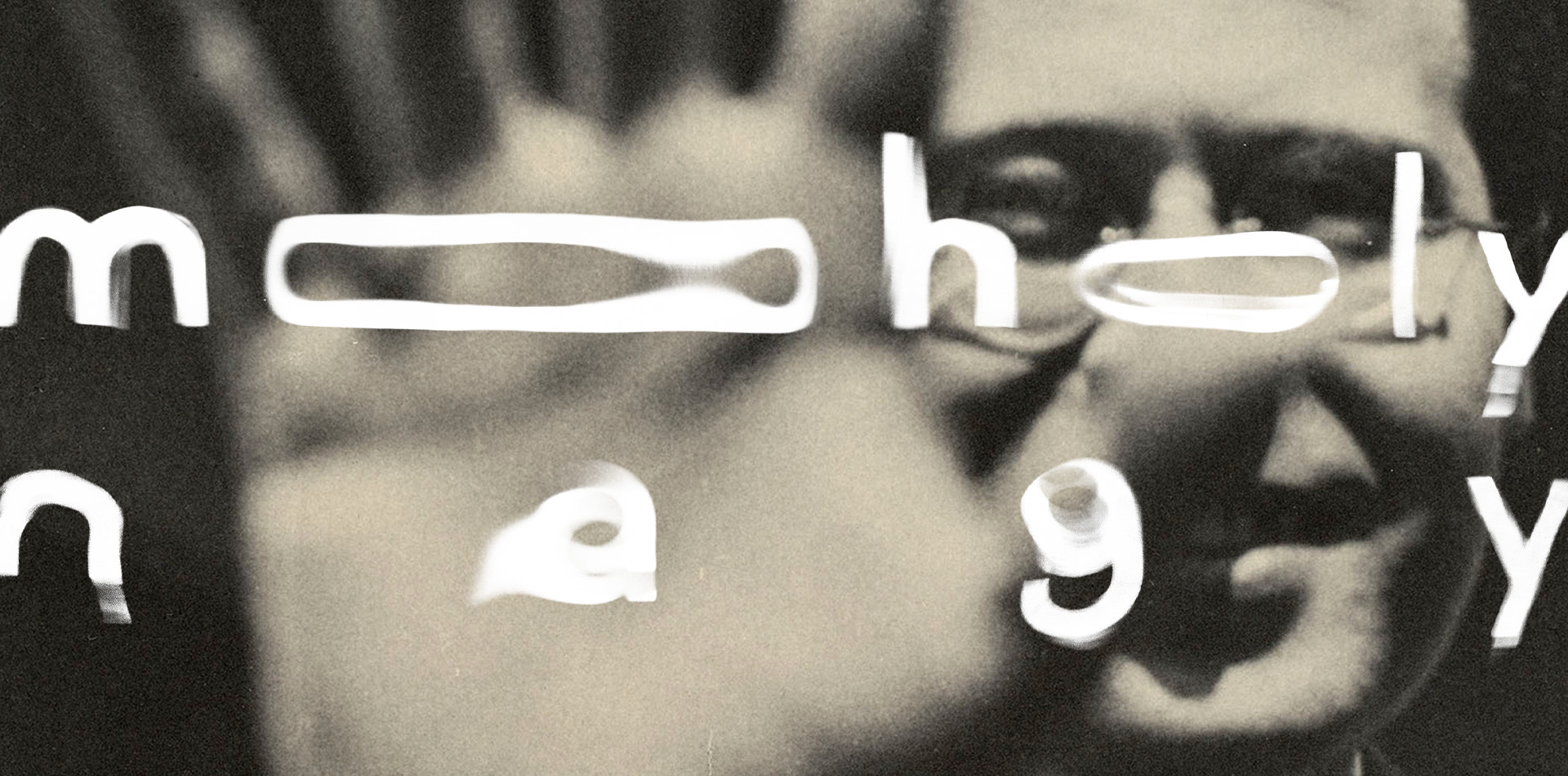

László Moholy-Nagy came of age during the First World War and launched himself as an artist during the post-War period of cultural ferment that enveloped the Western world. After the Great War finally ended, modernist trends in many fields, whose development the War had stifled, could now flower, and Moholy-Nagy became an active participant in several of them, gradually positioning himself on the cutting edge of art, photography, commercial design, stage and film, and design education.
His career path, his artistic production, as well as his personal life, were strongly influenced by large-scale cultural trends and historical events. He was very much a product of the turbulent history of the first half of the 20th century, a period of time that continues to be a subject of deep interest today. For example, the year 2009 was being celebrated in parts of Europe and the United States as the Bauhaus Year.
The Bauhaus, Germany’s most famous design school, was founded in Weimar by Walter Gropius in 1919. The widespread and long-lasting influence of the Bauhaus on modern design and design education is impressive, especially because it existed for only 14 years. Moholy-Nagy was appointed a master, or teacher, at the Bauhaus in 1923 and became one of the most enthusiastic proponents of its educational aims and methods. The spotlight that shines upon the Bauhaus also shines upon him. So, I am very pleased to have the opportunity to give you some details about the life and career of László Moholy-Nagy, a modern artist of the twentieth century, which – for many of us – was also our century.
László was born in 1895 in Borsód, now called Bácsborsód, a two-street village in southern Hungary. His father managed a large estate and the house the family lived in—and where he was born--came with the job. My Hungarian family, including my father, had little to say about this man, who was evidently a cause of extreme embarrassment to them. For years it was asserted that grandfather had gone to America and died over there. It was only a few years ago that I learned that he had walked out on his family when his children were young and never left Hungary. There were three surviving sons, of which László was the middle child. Their mother took the boys to her family, and their maternal uncle, Gusztáv Nagy, became their guardian. He was a lawyer and lived in a town called Moholy, which is now in Serbia.
One remarkable aspect of Moholy’s life is that he was able to benefit from the guidance and support from a succession of male mentors and female handmaidens. Perhaps he was willing to accept advice and help because of his childhood circumstances. Uncle Gusztáv – Guszti bácsi in Hungarian – can be considered the first of these helping hands. László and his younger brother, Ákos, went to gymnasium, that is, college-track high school, in Szeged, at that time the second largest city of Hungary after Budapest. In Szeged he received a top-notch education, which I believe influenced the way he came to view the world. Being acquainted with several fields of knowledge helped him see relationships between things, to look at things holistically.
At first László wanted to become a writer and while he was still in school some of his poetry was published in the Szeged newspapers. But when he graduated in 1913, Guszti bácsi encouraged him to begin law school in Budapest. He moved to the capital with his mother and brothers. World War I interrupted László’s law studies, which he never finished. He enlisted in the Austro-Hungarian army in 1915 as an officer in training in the artillery.
He had begun to draw even before he went into the army. But, during the many hours he was stuck in artillery observation posts, he turned to drawing to pass the time. He produced hundreds of sketches, many in color, on the backs of military-issue postcards that he could easily carry with him. They are colorful, lively, and often humorous. His left thumb was shattered by shrapnel in 1917 and he had a long convalescence in Budapest. He went on reserve military status. The War was a terrible experience for him. His social idealism began to crystallize at this time. He published short stories and literary criticism while in Budapest, but he was already thinking seriously of becoming an artist. He was encouraged in this by a friend from the university. Iván Hevesy, who later became an art critic, was another of his important early mentors.
In Budapest László attended evening art school classes and entered his work in exhibitions. So we can say that he embarked upon his career as an artist around 1918 at the age of 23. His paintings and drawings were figurative and tended towards Expressionism. He added the name of Guszti bácsi’s town to his own and became László Moholy-Nagy. He apparently became interested in photography at this time through another friend, Erzsébet Landau, who had her own photography studio in Budapest. Presently known evidence suggests that Erzsi Landau, gave or sold László one of her old cameras and set him on the path to becoming a photographer. Although I don’t know the exact date when he began to photograph, it was some time before he left Hungary.
When the War ended, Hungary went through a short period of revolution and political turmoil before a dictatorship was established under Admiral Miklós Horthy. László left Budapest and returned to Szeged. And from Szeged he went to Vienna at the end of 1919. From that time on, he was more or less on the move for the rest of his life. In Vienna he joined the MA group of Hungarian avant-gardes, who were in temporary exile from the political repression in their homeland. The group was led by the artist and writer, Lajos Kassák, who also strongly influenced Moholy’s career. But Moholy found Vienna uncongenial and went to Berlin in the spring of 1920.
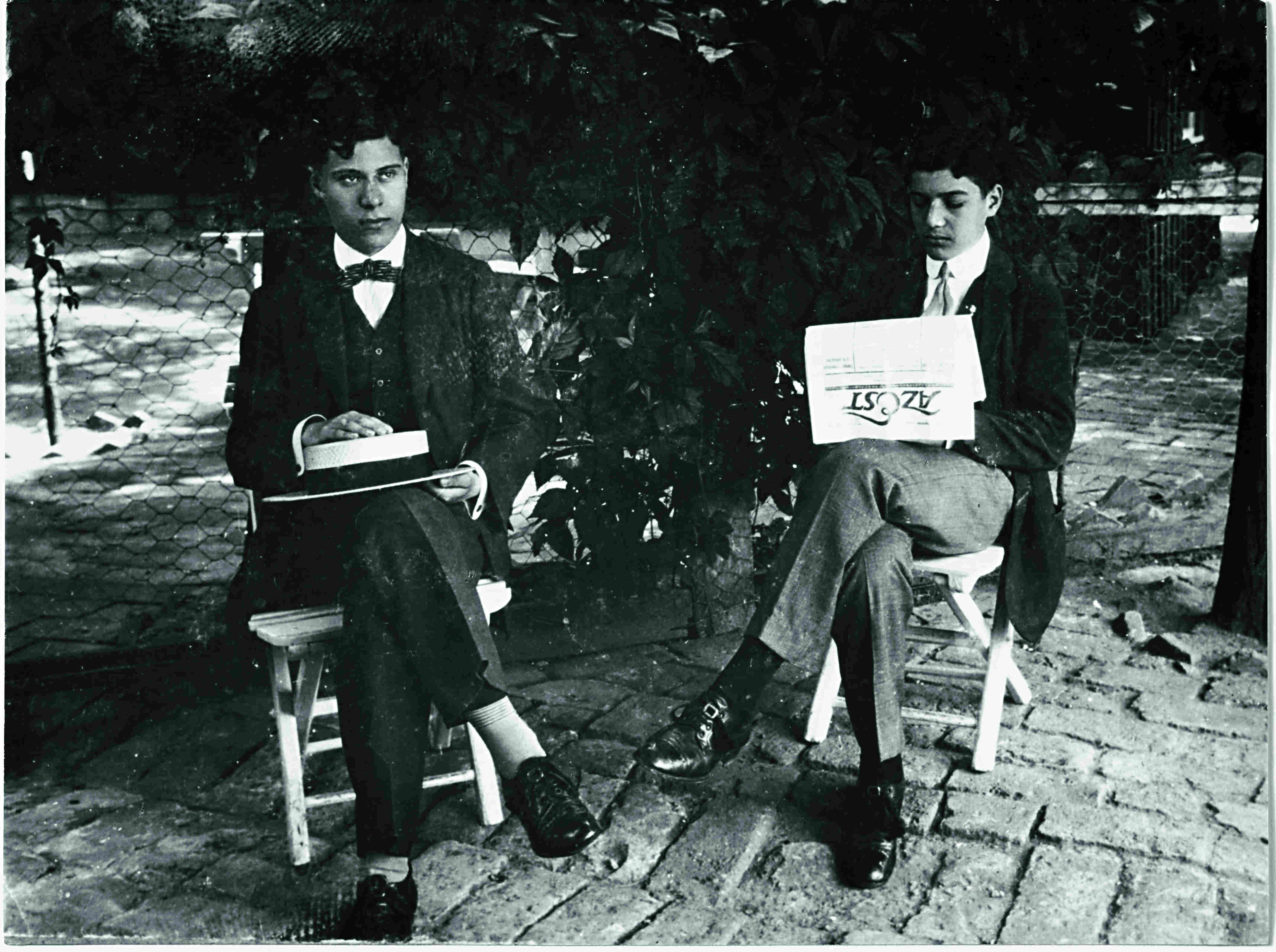
László and Ákos, Szeged, 1912
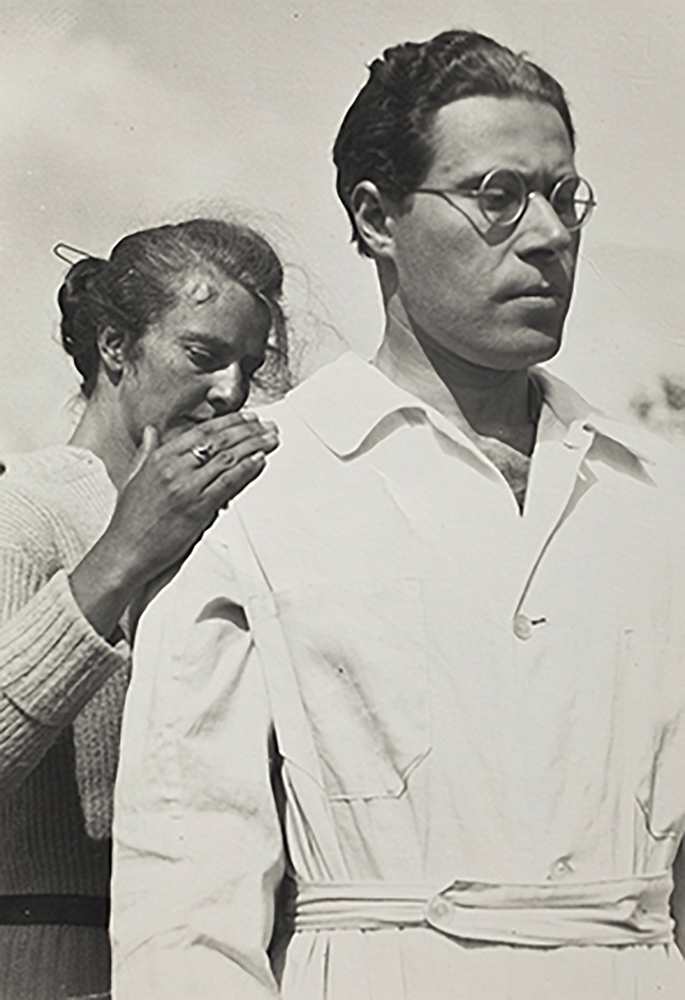
László Moholy-Nagy and an unidentified woman
Europe, 1920s
During the Weimar Republic between the two World Wars, Berlin was the Big Apple for Eastern and Central European artists and writers. The three years Moholy spent in Berlin during his first stay there must have been exhilarating for a young man in his twenties. The most significant development in his art is that it went from being figurative into a short Dadaist phase. And from there it went completely abstract.
Moholy was strongly impressed by the Russian Constructivists, who, for a short while, exerted considerable cultural influence in the newly established Soviet Union. Their work was exhibited in a widely-seen show in Berlin in 1922. Moholy embraced this new style with characteristic enthusiasm and energy. The earliest of his Constructivist paintings already illustrate Moholy’s life-long preoccupation with light and transparency, as seen in his signature intersecting and overlapping planes. The earliest paintings are static – they kind of stand and deliver. But by the mid-1920s his compositions had become dynamic and reflect his verve and optimism. He had developed his own individual style.
However, he was also strongly attracted to Constructivism for its social philosophy, which saw art and the artist as active agents in improving society. To put it somewhat simplistically, the Constructivists felt that a good art environment could promote good individual and communal values. Moholy somehow managed to retain his social idealism for the rest of his life. In Chicago he tried to promote it through his school. Besides painting on canvas, Moholy worked with collages on paper. He produced linoleum and woodcut prints, and sculptures of wood, glass, and metal. And in 1921 his personal life changed, when he married his first wife, Lucia Schulz. She was born in 1894 near Prague, now the Czech Republic, and died in Zurich, Switzerland, in 1989. She was a writer, an editor, and soon became a talented photographer - another capable woman who was of great help to Moholy.
Around 1922, Moholy became aware of the photogram, and Lucia helped him perfect his methods. A photogram is a photographic image made without a camera. Objects are set directly upon photosensitive paper or placed between a source of light and the paper to cast shadows on it. The photosensitive paper is exposed and then developed like any other photograph. Moholy’s first photograms were made in daylight on printing-out paper, which gives a brown tone to the image. His later work was done in the darkroom where he could use larger sheets of paper and achieve better control over lighting conditions. His earliest photograms tend to resemble his Constructivist compositions. But by the middle 1920s Moholy was skillfully manipulating light and shadow to develop a distinctive photogram style. Everyday objects could be transformed into luminous, ambiguous forms floating through dark space.
A photogram is a unique image. But it can, in turn, be photographed to provide a negative from which other prints can be made. And it can be copied directly as a reversed image by placing another sheet of photosensitive paper on it and shining a light through both sheets. Moholy often used this technique to study its effects on texture and composition. Photograms fascinated Moholy for the rest of his life. In Berlin he came to the attention of Walter Gropius through an exhibition held in the avant-garde art gallery, Der Sturm. Gropius was the director of the Bauhaus, which he had founded in Weimar in 1919. He hired Moholy as a master or teacher. In 1923 László and Lucia moved from Berlin to Weimar, and then went with the Bauhaus to Dessau in 1925.
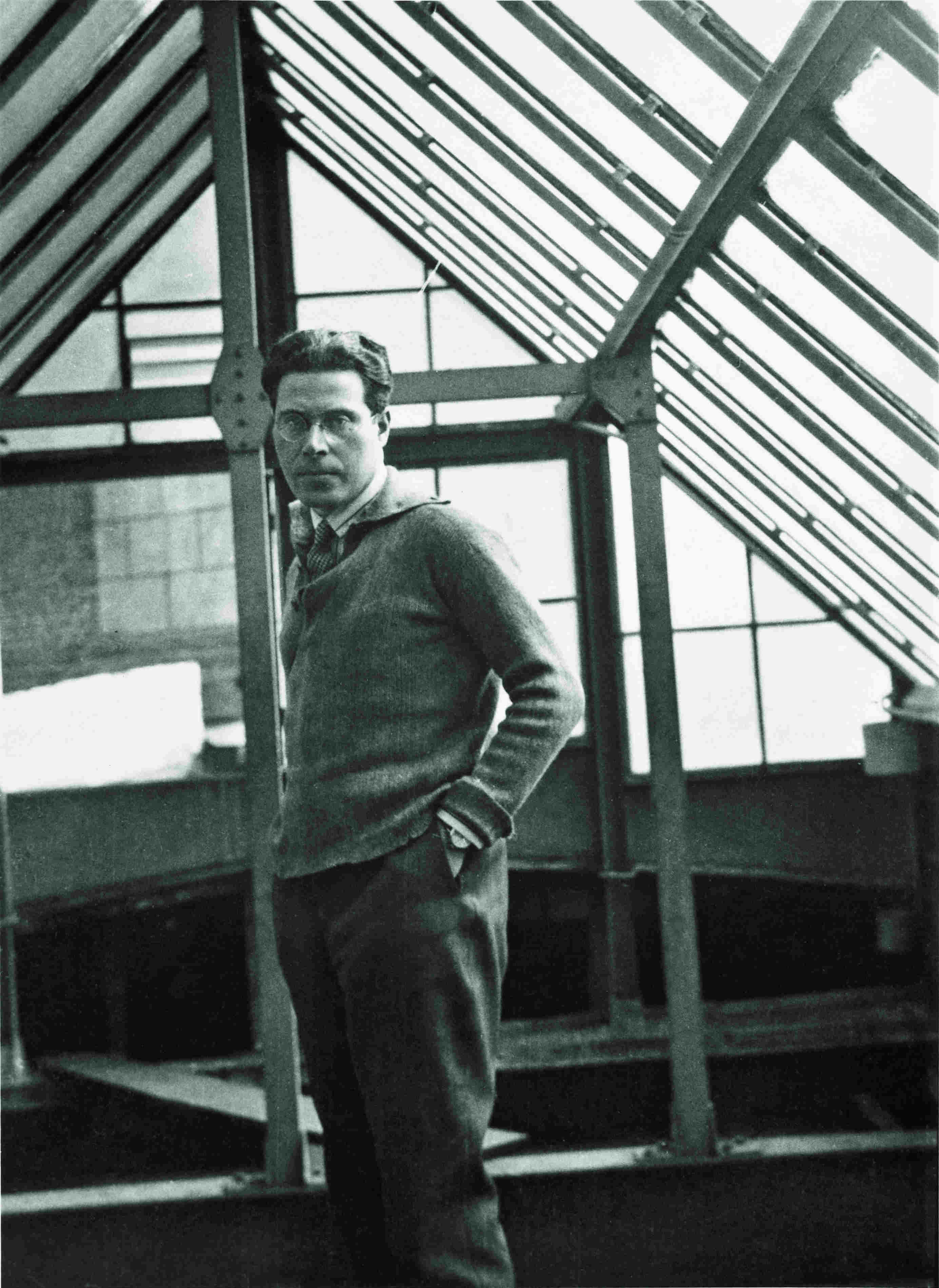
László Moholy-Nagy
1920s
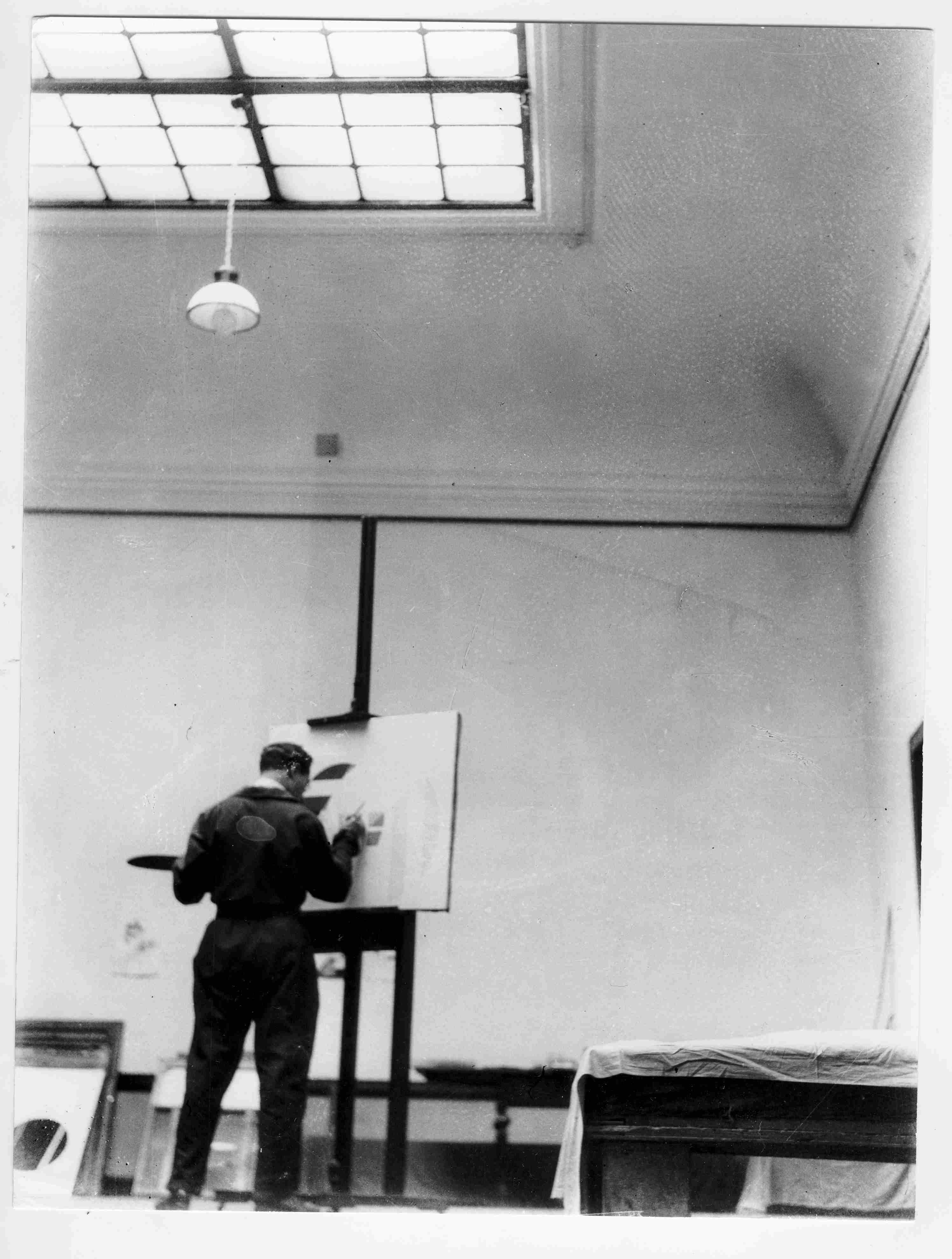
László Moholy-Nagy in his atelier
Weimar, 1923
The German architect, Walter Gropius, had founded the Bauhaus (which is a coined word meaning something like “construction house”) as a new kind of school of architecture, art and design. Its stated goal was to promote “a new unity of art and technology in the service of humanity.” Gropius, too, can be regarded as another of Moholy’s mentors, and they enjoyed a close friendship that lasted over 20 years until Moholy’s death. The Bauhaus pursued a holistic philosophy. It aimed at educating the whole person, with the rationale that only this kind of education would give the student a better grasp of society and an understanding of how the products he or she would design could improve it. The social improvement aspect dovetailed nicely with Moholy’s own social idealism. The Bauhaus also put more emphasis on the process of education than on the concrete results. Teamwork was encouraged, among the students and among the different departments, called workshops, e.g., in the designing and furnishing of a house. Moholy was hired to direct the Metal Workshop.
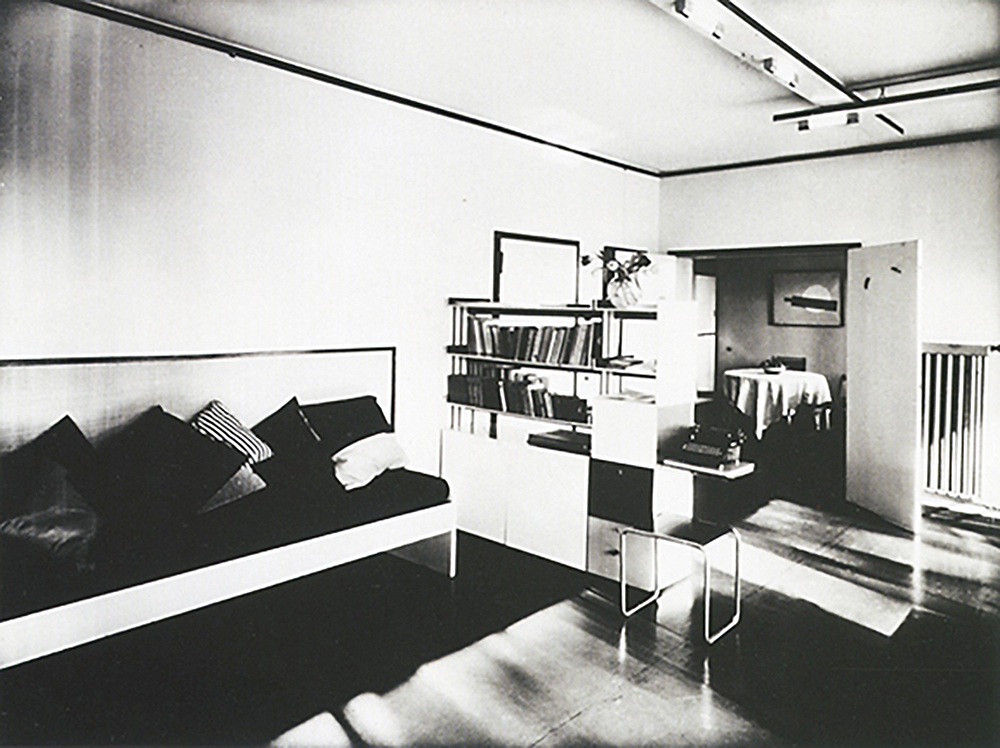
Living room of László and Lucia Moholy-Nagy's Master House
Dessau, Germany, 1926
A Foundation Course, required of all students before they were allowed to specialize, was one of the Bauhaus’s most important innovations. It encouraged experimentation as a way to acquire direct knowledge of tools and materials, and to open up unexpected possibilities. Students were to view tools and materials without preconceived notions. They were encouraged to think outside the box. For exmple, a 2-dimensional sheet of flexible paper could be used to make a rigid, 3-dimensional structure or, conversely, flexible or see-through structures could be made of hard, rigid material like wood. At the Bauhaus Moholy continued to develop his painting. Besides canvas, he also painted on aluminum and some of the new kinds of plastics that were coming into production at the time. He experimented with spray guns.
He continued to make camera photographs. Some recorded Lucia or his friends, but most of the better known images of this time are in the Formalist style and show strong compositional resemblances to his paintings. Like several other avant-garde artists of the 1920s and 1930s, Moholy also created a body of Dadaistic photomontages, which he called “photoplastics,” the “plastic” referring to sculpture rather than to synthetic substances. They are usually read as social commentary. Later he continued to use photomontage in the commercial work he did for a living after he left the Bauhaus, as in advertisements, book jackets, and magazine covers. Sometimes he incorporated photograms, or drawings into his commercial work.
In keeping with the Bauhaus philosophy, Moholy felt there was no barrier between fine art and commercial art. He published many articles that were translated into several languages, and he wrote two books for the Bauhaus Books series that he co-edited with Gropius. One of them about Bauhaus education, was translated into English as The New Vision. This book has enjoyed especially wide influence and a long, active life. In fact the latest edition appeared in 2005. In 1928, due to internal, mostly political upheavals at the Bauhaus, Gropius resigned the directorship and returned to Berlin to set up an architectural practice. Accordingly, Moholy also left the Bauhaus and moved to Berlin, where his marriage broke up and he and Lucia separated. Within a few years the Bauhaus was forced out of Dessau and reopened in Berlin, where it famously closed under Nazi pressure in 1933.

László Moholy-Nagy at the Bauhaus Master Houses
Dessau, 1920s
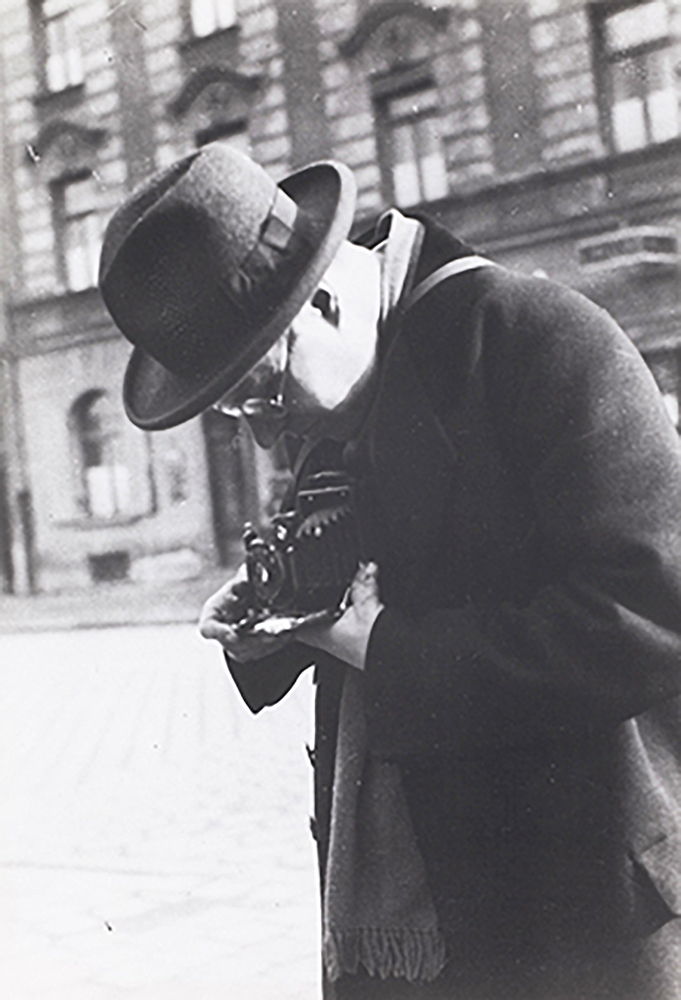
László Moholy-Nagy with his Ernemann camera on the streets of Berlin
Berlin, 1930s
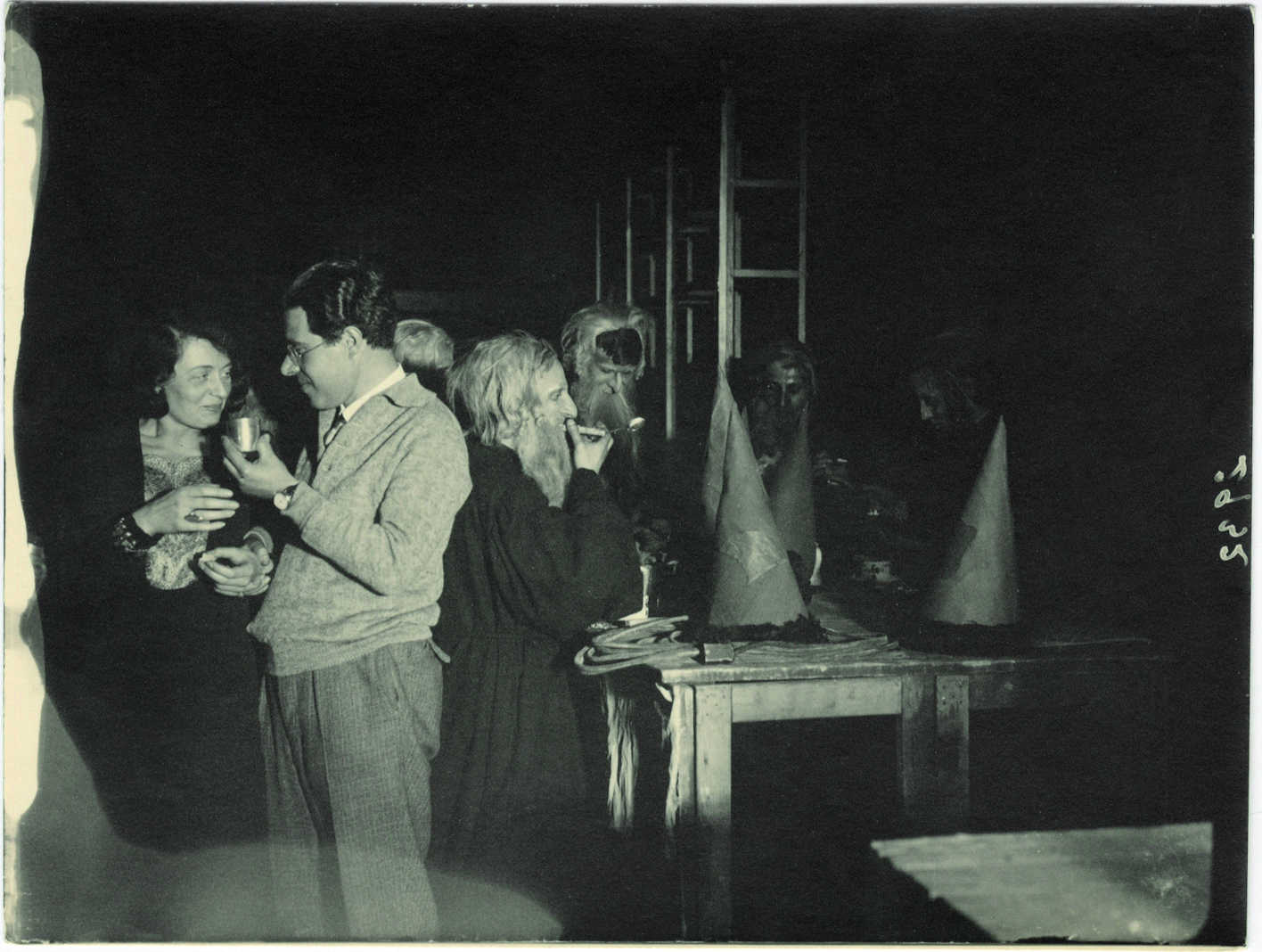
Backstage at Kaufmann von Berlin
Berlin, 1929
Moholy was extremely active during this, his second Berlin period. He had to be because he was now earning his living as a free-lance designer. He set up a studio and did advertising, exhibitions, stage designs and costumes. He made some of his best-known camera images during this period and published them in magazines and books all over Europe. His photographs are characterized by multiple exposures, strong diagonals, worm’s-eye views, bird’s-eye views, and incorporation of shadows. He produced many photograms. A new development was making negative prints of photographs. Similar to the reversed photograms, these negative pictures allowed him to explore the different impacts tone and shading had upon composition. Moholy was one of the earliest artists to create art with purely mechanical means. He also believed that the concept behind a work of art was its most important aspect, not who actually created it. He did not develop his own photographs or photograms, and much of his Berlin and London theater and commercial design work was actually executed by artists working in his studio. This idea of the privileged importance of the original concept still lives on in contemporary art.
During his second stay in Berlin, Moholy became interested in the artistic potential of the motion picture. Between 1929 and 1936 he shot several black and white short films, of which seven are still extant. He made his best-known film in 1930. Called (in English) “A Lightplay - black white gray,” this film has become a classic of early experimental motion picture. It records the movements and light effects produced by a kinetic sculpture he designed. Variously referred to as The Light-Space Modulator, The Light Machine, and Light Prop for an Electric Stage, it was constructed of metal and glass and driven by an electric motor. By now, it has become Moholy-Nagy’s iconic work. The Light-Space Modulator continued to make sporadic appearances in various media in Moholy’s work for the next decade.
From my personal point of view, one of the most significant events of Moholy’s second stay in Berlin occurred during the winter of 1931, when he met the woman who would become his second wife and the mother of his two daughters. Sibylle Pietzsch, later known as Sibyl Moholy-Nagy, was born in Dresden, Germany, in 1903 and died in New York in 1971. She was a gifted writer, eventually in two languages, and in later life became a professor of architectural history. After a lackluster career as a stage and film actress in the 1920s, she moved to Berlin and became a film dramaturge and scriptwriter. One day Moholy showed up at the film company where she worked to try to get support for a film about Berlin. Sibyl’s exasperated boss finally sent her out to the reception area to get rid of that persistent character with the unpronounceable name. And that, ladies and gentlemen, is how it happened.
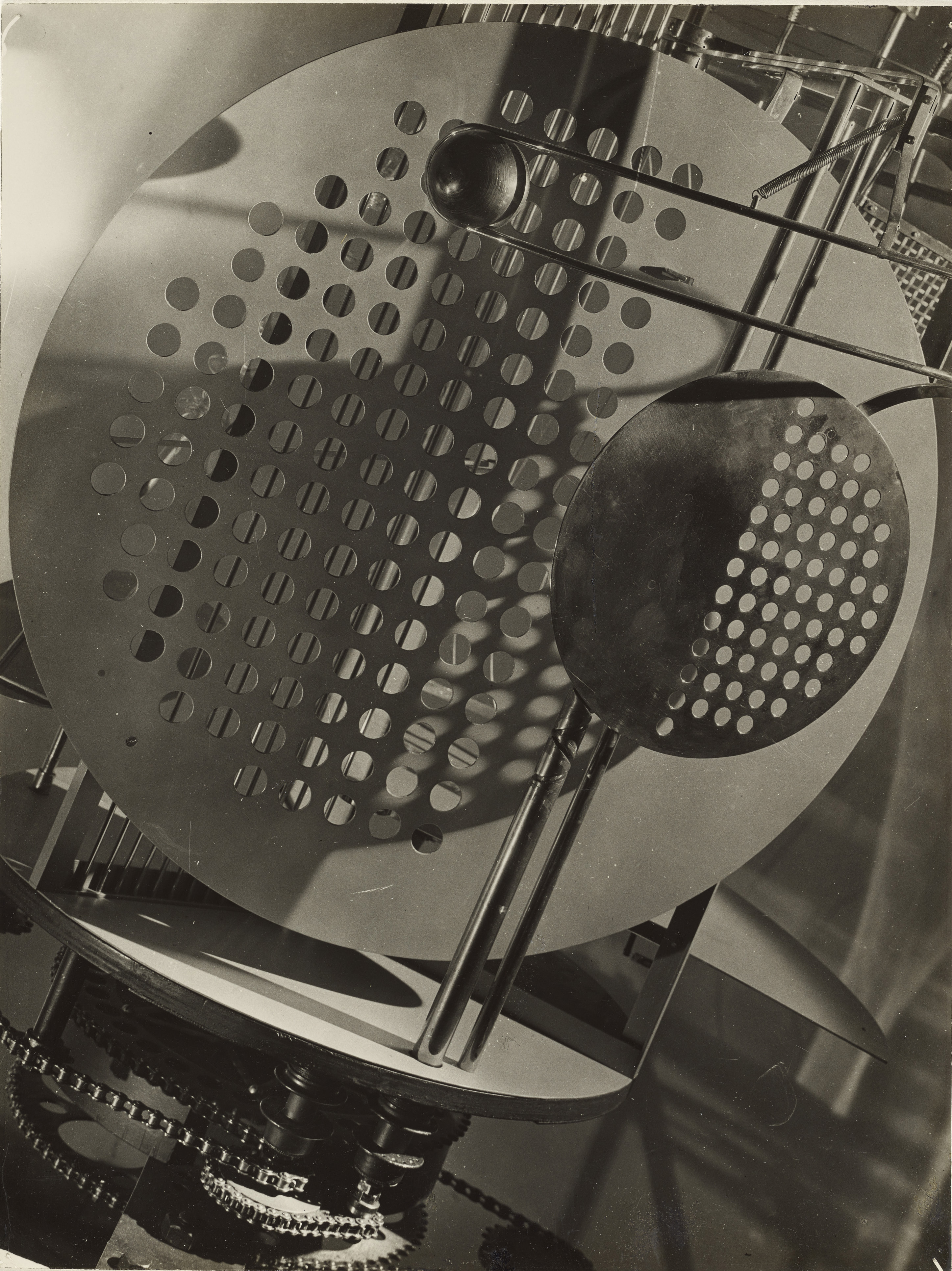
Light Space Modulator a.k.a. Light Prop for an Electric Stage
1931
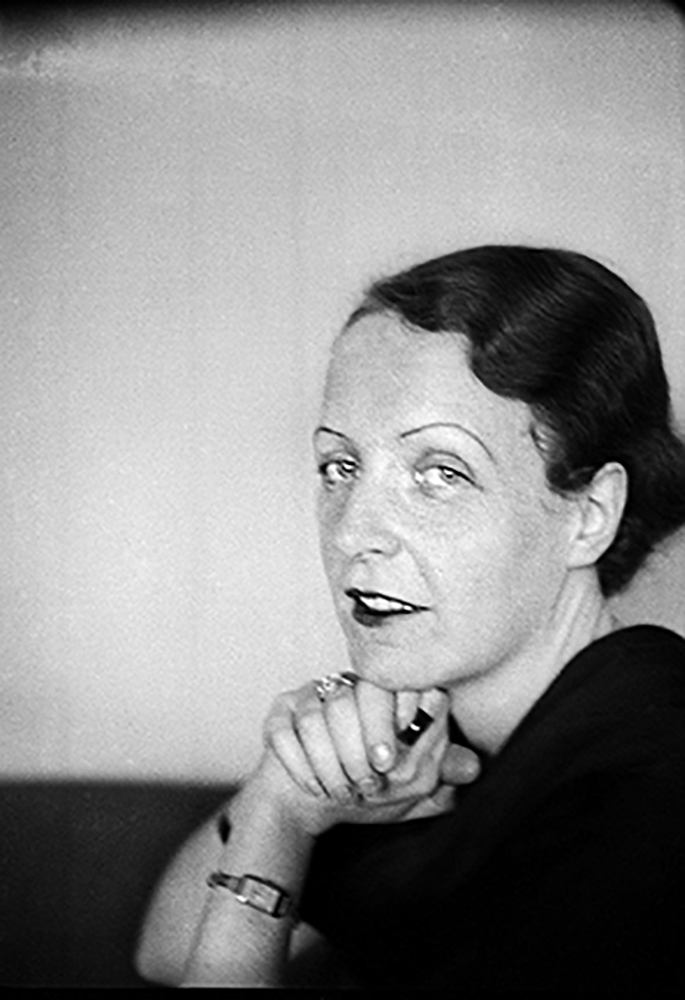
Sybil Moholy-Nagy
Germany, 1930s
After Hitler came to power in 1933, it became increasingly difficult for avant-garde artists, architects, and designers to make a living in Germany. Many of them began to look for work in other countries. In 1934 Moholy accepted a job with a design firm in Amsterdam and moved to Holland, where he continued to do advertising work and exhibition design. A significant development during his year in Holland was the use of color photography, at first in his commercial work. He regularly commuted to England to learn about color processes.
After his contract in Holland expired in the spring of 1935, Moholy moved to London, the new home of several other self-exiled Bauhaus people, including Walter Gropius. Our reunited family lived in the northern part of London near Hampstead Heath. Moholy was joined in London by his long-term collaborator, György Kepes, with whom he had worked in Berlin. My sister, Claudia, was born in London in 1936 and died in New York in 1971. A fellow Hungarian, the film director Alexander Korda, invited Moholy to work on the movie, “Things to Come,” which was released in 1936. He was to design the sequence showing the construction of the city of the future. Moholy designed a set of bright, almost ethereal structures and kinetic sculptures of transparent materials. But these designs turned out to be much too far in the future and they can only be glimpsed in the finished film.
During his stay in England Moholy began to paint more frequently on transparent plastics. In these transparent materials he saw the possibility of incorporating motion into his paintings. First, directly, as movable plastic leaves attached to a white board and then by painting or incising the plastic, or cutting holes into it. The plastic sheet was then mounted above a white surface, so that the cast shadows could be incorporated into the composition. The shadows move with the light source. A later development of the 1940s was to paint the plastic and then mold it. Since there was no name for this kind of art, he called his hybrid painting-sculpture creations “light modulators.” The downside to his fascination with transparent plastics, especially with Plexiglas, is that most types proved to be unstable over time and discolored, shattered, or warped and deteriorated beyond recognition. So, sadly, only a few of these beautiful and innovative pieces survive today. Moholy did a lot of camera photography in England. He continued to explore the potentials of color photography. At some point during his stay in London, he acquired a 35mm Leica camera.
Meanwhile, back in Chicago, the Association of Arts and Industries, a group of businessmen, decided to realize a long-held desire to open a design school of their own. Their aim was to educate industrial designers, who could provide them with improved products for their businesses. They were impressed with the achievements of the German Bauhaus and invited Walter Gropius to direct their new school. Gropius, however, had just accepted a position at Harvard University. So he recommended his former Bauhaus colleague, László Moholy-Nagy, for the position of director. Moholy was overjoyed at the opportunity to teach again, to be able to spread the word. By the fall of 1937 we were settled in Chicago. The school opened in October of 1937 in a converted mansion on Prairie Avenue, which had been built by the department store tycoon, Marshall Field. Moholy called the school “the new bauhaus: American School of Design.” He had a readymade educational blueprint for his Chicago school. Many of the teaching methods and exercises were essentially those of the Bauhaus, adapted to American circumstances. The objective was also the same, namely, to educate the whole person, so that he or she could make a contribution to society.
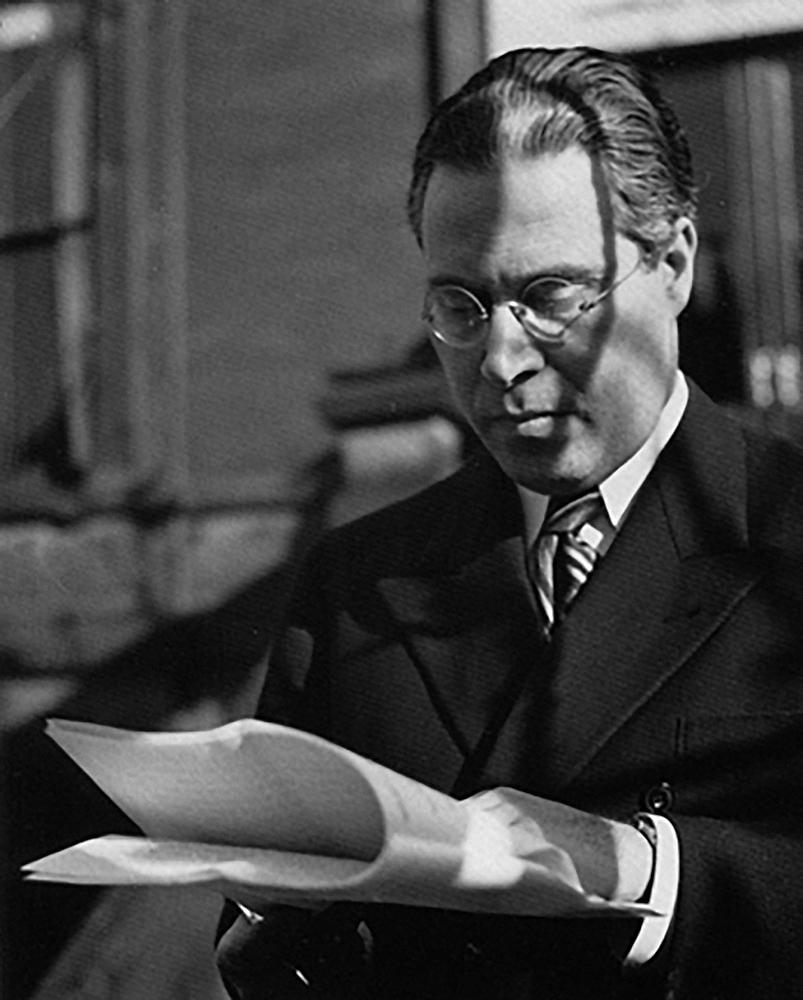
Moholy-Nagy reviewing his notes at the opening of the New Bauhaus. Herbert Matter photograph
Chicago, 1937
However, the New Bauhaus closed in June of 1938, done in by student unrest and financial difficulties. But Moholy did not abandon his hope of establishing Bauhaus education in America. In February of 1939 he was able to open his own school. He called it “The School of Design in Chicago” and the first of its several locations was in a former bakery in the Schatz Building on East Ontario Street.
The School held day and evening classes, as well as six-week summer sessions and Saturday morning children’s classes. From then on, until the end of his life, Moholy’s time, energy, and financial resources were devoted to keeping this School afloat. It became like a member of the family. Somehow he managed to keep it going through the Second World War, the most destructive war in history. It was primarily financial support from Walter P. Paepcke, another of Moholy’s helping hands, which enabled the School of Design to open and operate. Paepcke was the head of the Container Corporation of America and a former member of the Association of Arts and Industries. The same Walter Paepcke who later put Aspen, Colorado, on the map as a ski resort and cultural center. It is doubtful that the School could have survived without him. Additionally, the Paepckes made available for School summer sessions a property near Somonauk, Illinois, about 75 miles southwest of Chicago. Paepcke also assumed the important role of liaison between the School and the Chicago business community, whose support was crucial to Moholy, but who often didn’t understand where he was headed.
In 1944 the administration of the School of Design was reorganized and the School was given the more significant name of “The Institute of Design.” In 1945 the Schatz Building was sold and the School had to move temporarily to quarters at State and Rush Streets. After the fall of 1946 the Institute of Design moved several times. It became a department of the Illinois Institute of Technology in 1949. The Institute of Design still continues its mission as a department of IIT, a direct descendant of the School Moholy founded over 75 years ago. With the School the main focus of his time and energy, one wonders that Moholy had time for anything else. But he continued to paint, photograph, and publish. This was, in part, because he was blessed with great reserves of energy. But it was also because he had such efficient support in his wife, Sibyl, another capable woman who was devoted to his cause. Without her he could not have accomplished all that he did in his nine years in Chicago.
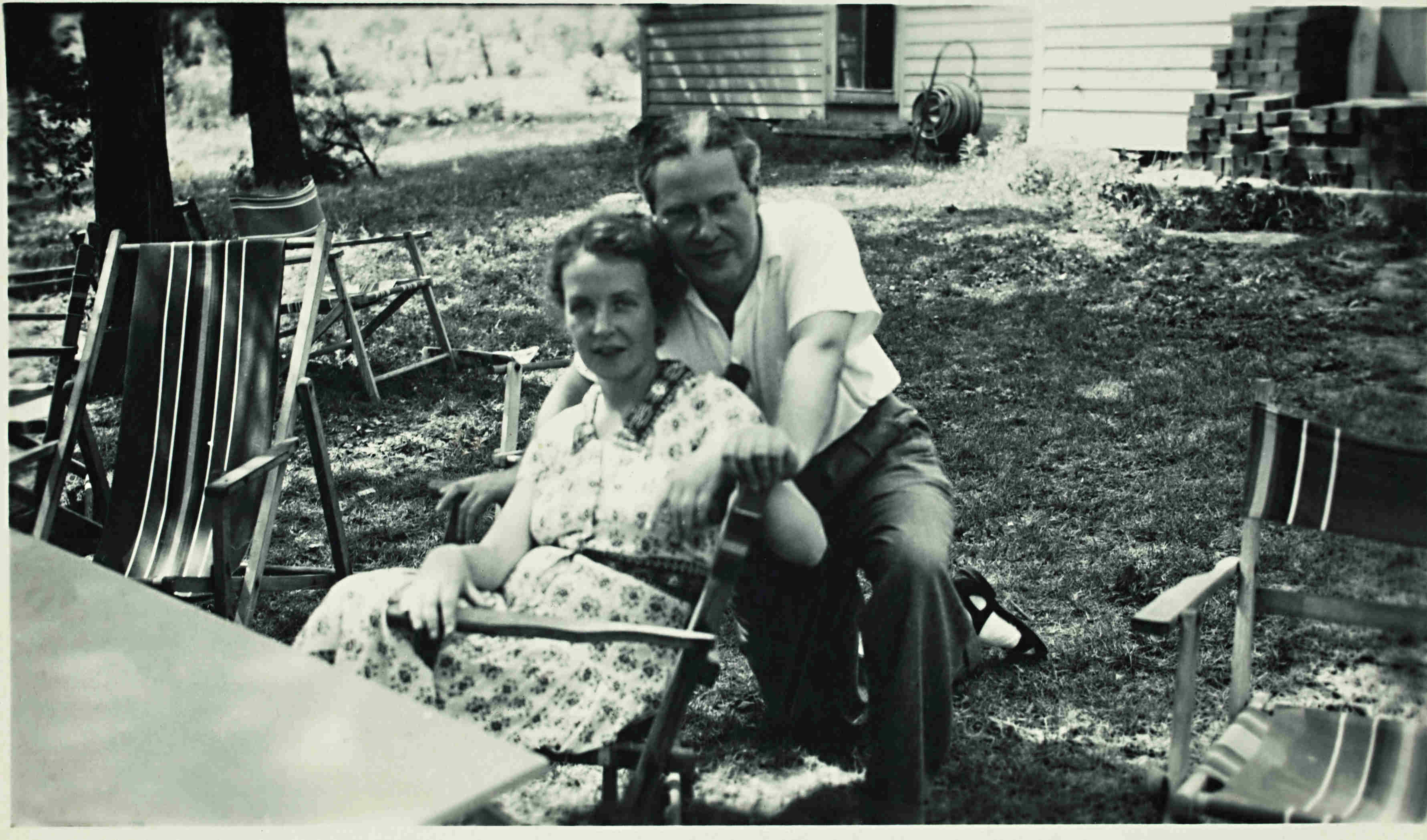
Sybil and László Moholy-Nagy
Somonauk, Illinois, 1939
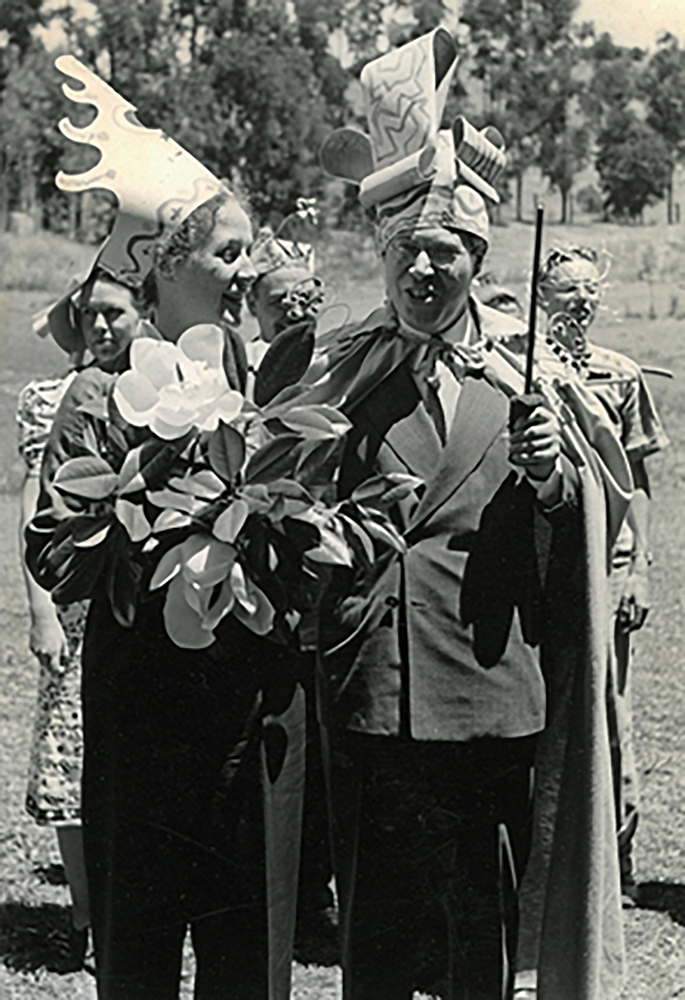
László and Sybil Moholy-Nagy and students celebrating Moholy-Nagy's 45th Birthday at Mills College
Oakland, California, 1940
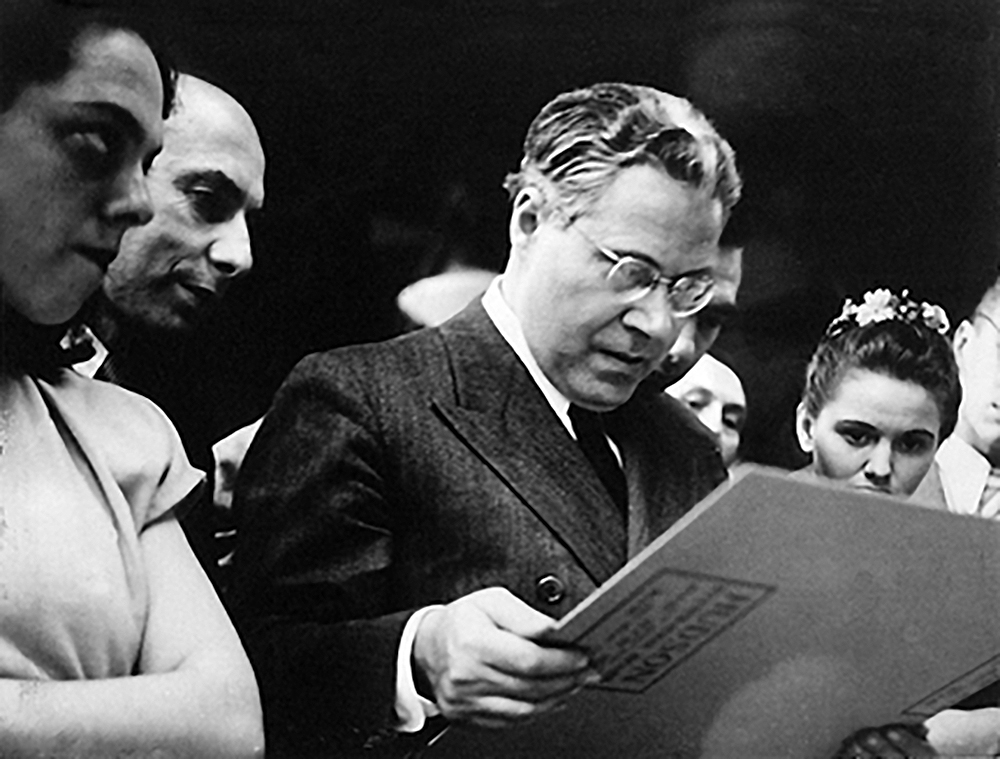
Class Critique at the School of Design in Chicago
Chicago, United States, 1940s
He set up his easel at home in a corner of the living room - where we were forbidden to get within six feet of it. He painted mostly at night when he got home from the School and created paintings on canvas and plastic. His style of the 1940s became even livelier and more colorful, and he had clearly moved away from the classic geometric forms he had used in the 1920s. In particular, his many drawings and collages on paper demonstrate his great versatility. In Chicago he began to make sculptures of Plexiglas. He made some of them at home, heating the precut Plexiglas sheets in the kitchen oven. Watching the sculpture take shape in his hands was always very exciting.
He continued to make, publish, and exhibit photograms, which have the dynamic, curvilinear qualities of his paintings and sculptures. But what of his camera photographs? When Moholy’s camera photographs are shown or published, they are invariably the black and white images he made in Europe. I wondered about this for years, because I remembered him constantly shooting pictures. Because, as I mentioned earlier, he did not do his own printing, he took his time composing his images in the camera viewfinder, which could be a tedious procedure for his sitter.
He made black and white photographs that look as though they were intended as advertising. He made portraits of pretty young women, one of his favorite subjects. He photographed his family. But, in contrast to his practice of the 1920s and 1930s, none of these photographs were exhibited or published in his lifetime. What apparently happened is that after Moholy came to the States, he photographed mainly in color. He continued his earlier experiments with color photography using the new Kodachrome slide film that had come on the market in 1937. He made hundreds of 35 mm color slides with his Leica camera, of which a remnant has survived. They encompass all of the subjects of his earlier black/white photographs: travel pictures, evocative portraits, family pictures, Formalist compositions, as well as documentation of the activities and student projects of the School.
My favorites are light abstractions, his success at creating pictures with nothing but light and color. But the technical processes of the time did not permit the high-quality color reproductions we enjoy today, and so his latest camera photographs remain relatively unknown. So far I have only found one published camera photograph from the Chicago period, a high-spirited composition in the November, 1937 issue of Fortune magazine. Described in the caption as a holiday greeting, it can also be read as a subtle ad for United Airlines, whose chairman, Thomas Patterson, was on the board of sponsors of the School. Moholy also continued to shoot films, mostly of the School. These films are in color and are silent. He lectured to them as he traveled around the United States to promote the School. They are wonderfully vivid records of the School of the early 1940s. My aim here is to show that after he came to Chicago, Moholy explored the possibilities of color photography as energetically and enthusiastically as he did all other media with which he came into contact.
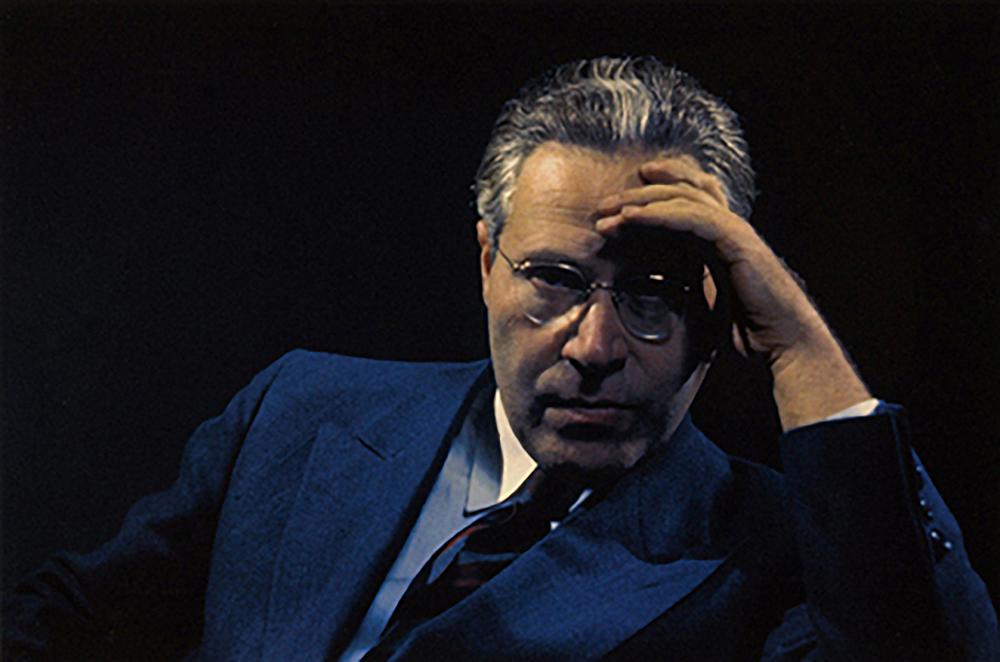
Self portrait of László Moholy-Nagy
1940s

Claudia and Hattula Moholy-Nagy, Lakeview Avenue apartement
Chicago, 1945
In December of 1945, Moholy was diagnosed with leukemia. He underwent X-ray treatments, which enabled him to carry on his superhuman schedule for another year, and he died on 24 November 1946 at the premature age of 51. His ashes are buried in Graceland Cemetery in Chicago, his adopted city. In 1999 he was honored with a Chicago Tribute Marker. His last book, Vision in Motion, was published posthumously in 1947. In it he sets out his educational philosophy and its foundation in the principles of the Bauhaus. He presents its actualization in the curriculum and the products of the School. To this day, Vision in Motion remains the most complete guide to what the Institute of Design, under Moholy, was all about.
I have given you a few highlights in the life of László Moholy-Nagy and what he accomplished along the east-west trajectory that took him from Bácsborsód, Hungary, to Chicago, Illinois--a trajectory propelled by personal inclinations, helping hands, serendipity, and the momentous historical events of the first half of the 20th century. The vast distance--geographical, cultural, and professional--that he covered in his relatively short life is astonishing. One can only admire the energy, the genius, and the incredibly optimistic idealism that carried him such a long way in such a short time.
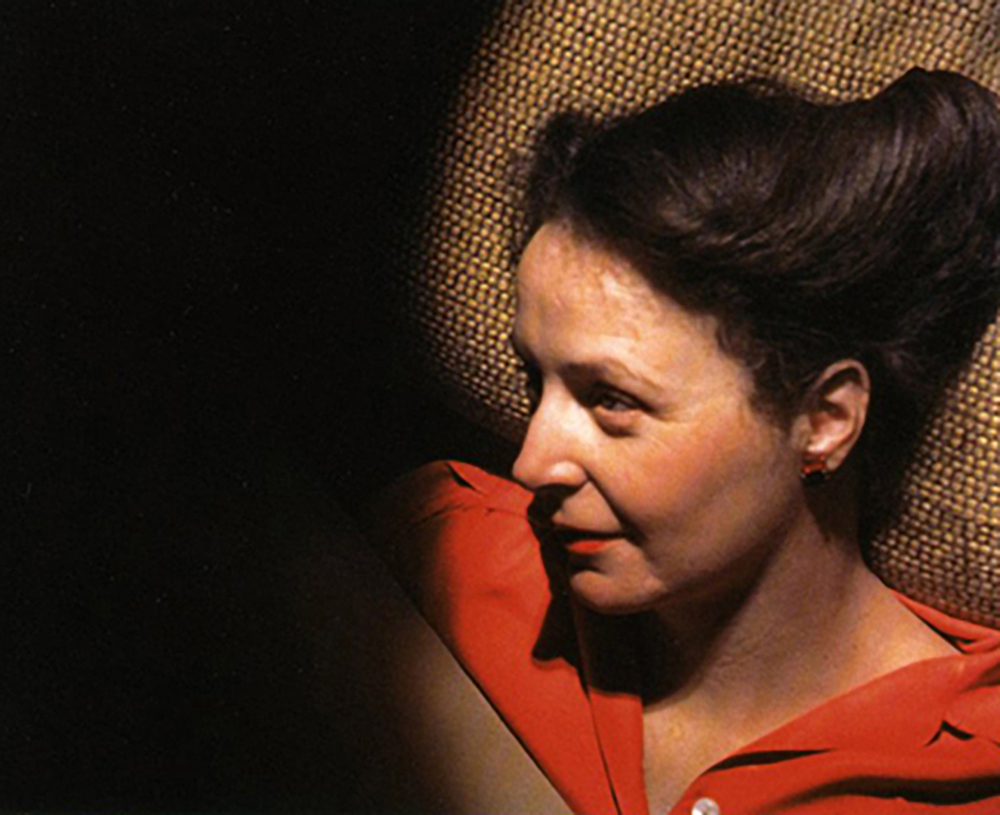
Sybil Moholy-Nagy, Lakeview Avenue apartement
Chicago, 1940s